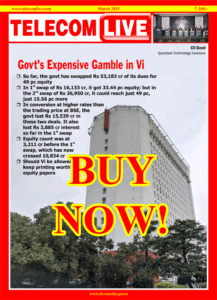Reliance Jio’s network expansion drives 5G SA availability to 52% in India in 4Q24: Ookla
Driven by Reliance Jio’s fifth-generation (5G) network expansion, the 5G standalone (SA) availability in India reached 52% in Q4 2024, second only to China which led with an 80% 5G SA availability, according to the latest data released by network testing firm Ookla on Monday.
5G availability, as per Ookla, is the metric for the percent of users on 5G-capable devices that spend the majority of their time connected to a 5G network.
Mukesh Ambani-led Jio in the December quarter (Q3FY24) reported a 5G user base of 170 million, as more users upgraded to 5G smartphones on the back of the nationwide availability of 5G services.
“…the combination of having that [pan-India network available and the increasing adoption of 5G devices in our subscriber base has resulted in the number of Jio 5G subscribers crossing 170 million as of December 24. Moreover, 5G now accounts for a large chunk of the traffic on our network,” said Kiran Thomas, President, Reliance Jio Infocomm, at Reliance Industries Limited’s (RIL) most recent post-earnings call.
Thomas said that 5G has a share of nearly 40% of the wireless traffic of an overall 15 exabytes (EB) of traffic at Jio. “…the total 5G traffic on our network will surpass the 4G traffic very, very shortly.”
Gopal Vittal, Vice Chairman & Managing Director of Bharti Airtel at the telco’s Q3FY25 post-earnings call said that 5G on SA architecture offers better uplink speeds even during network congestion.
“…but today, with an empty network, we have not reached that point,” Vittal said, adding that Airtel has already tested fully the SA solution for FWA, but is currently not seeing any uplink differentiation vis-a-vis 5G non-standalone (NSA)-based FWA due to relatively uncongested networks currently.
‘Asymmetric access to 5G SA’
According to Ookla’s study, there are a limited number of countries with multiple telcos offering commercial 5G SA services, resulting in “highly asymmetric access” to the technology across subscribers.
This trend, it said, is evident in leading countries such as the US and India, where high 5G SA availability is concentrated in a single operator – T-Mobile and Reliance Jio, respectively – driven by aggressive nationwide low-band deployment.
“In Jio’s case, this was further bolstered by its unique decision to skip the NSA architecture entirely in favor of a full 5G SA rollout,” Ookla noted in its study.
Notably, the US ranked behind China and India with a 24% 5G availability, while Europe lagged severely with just 2% 5G availability despite its highly ambitious 5G infrastructure targets among the most advanced liberal economies, according to the study.
“The region (Europe) also lagged behind its peers on other key metrics, with the median European consumer experiencing 5G SA download speeds of 221.17 Mbps—lower than those in the Americas (384.42 Mbps) and both Developed (237.04 Mbps) and Emerging (259.73 Mbps) Asia Pacific,” the network analysis firm said in its findings.
It found that earlier deployments, a diversified multi-band spectrum strategy, and greater willingness in telecom operators to invest in the 5G core to monetise new use cases have driven rollout at a faster pace in regions outside Europe.



